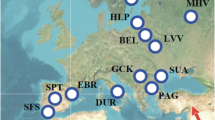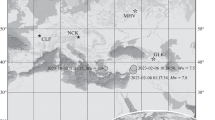Abstract
An analysis of variations in the microbaric background and the terrestrial magnetic and electric fields in the surface layer of the atmosphere accompanying strong earthquakes that occurred on February 6, 2023, in Turkey, is presented. The analysis involved the results of instrumental observations performed at the Moscow Center for Geophysical Monitoring and the Mikhnevo Observatory (Institute of Geospheric Dynamics, Russian Academy of Sciences), as well as the data obtained by a number of magnetic observatories of the INTERMAGNET network. It is shown that, in addition to the seismic effect, these earthquakes were accompanied by variations in the magnetic and electric fields, as well as by the generation of infrasonic waves recorded at a considerable distance from the sources.
Similar content being viewed by others
Avoid common mistakes on your manuscript.
Strong earthquakes are a clear example of natural forces. Dynamic effects in the source zone of an earthquake are related to the release of accumulated energy, to abrupt changes in the structure and mechanical and electrophysical properties of the geomedium, and to other phenomena accompanying earthquakes. These effects considerably affect variations in geophysical fields such as the electrical, magnetic, and microbaric fields [1]. Studies of induced variations in geophysical fields are of significant interest, not only because of comprehensive description of the earthquake-accompanying effects, but also from the perspective of understanding the inner mechanisms and development regularities of these effects. It should also be noted that quite strong variations in the geophysical fields contain information important for the development of models describing interactions and transformations of the geophysical fields, and, in general, for establishing the nature and mechanisms of interactions between geospheres [2].
Despite certain available studies related to establishing geophysical effects of earthquakesFootnote 1 (e.g., [3–5] and others), there is a lack of observation data which are necessary to expand the respective database as a basis for development of theoretical and phenomenological models of strong seismic phenomena.
The present communication considers the geophysical effects in the form of microbaric variations, as well as variations in the terrestrial magnetic and electrical fields in the near-surface layer, in the period of the three very strong seismic eventsFootnote 2 that occurred on February 6, 2023, in Turkey (Table 1) [6]. Notably, taking into account the short-term interval between the first two earthquakes, these events can be considered as a doublet earthquake.
The initial data used were those of instrumental measurements performed at two experimental subdivisions of the Sadovsky Institute of Geospheric Dynamics, Russian Academy of Sciences: Mikhnevo Geophysical Observatory (MHV, 54.96° N, 37.76° E) and the Moscow Center for Geophysical Monitoring (CGM, 55.70° N, 37.57° E) [7]. The vertical component of terrestrial electric field strength E was recorded using a BOLTEK EFM-100 instrument in the frequency range of 0–10 Hz. The magnetic induction components Bx, By, and Bz, oriented in N‒S, E‒W, and vertical directions, respectively, were recorded at MHV using a LEMI-018 digital three-component ferroprobe magnetometer with a sampling frequency of 1 Hz. When analyzing induced geomagnetic variations, we also involved the data from a number of magnetic observatories of the INTERMAGNET network [8] (Table 2).
It should be noted that the period when the earthquakes under discussion occurred was characterized by quiet meteorological conditions at the recording points, by the absence of significant local disturbances of the atmospheric electrical field from natural and technogenic sources, and also by quiet geomagnetic conditions (Table 3). All these factors on aggregate favored the distinguishing of induced disturbances in the geophysical fields studied.
Seismic Effect
A seismic signal is traditionally considered as the primary coseismic effect. In the case of the present event, the arrival of seismic waves to CGM from the doublet earthquake (lines 1 and 2 in Table 1) was recorded at around 01:22 UTC (Fig. 1); notably, the arrivals of surface wave groups from two individual events can be distinguished in the records.
Acoustic Effect
Another important effect is acoustic disturbances in the near-surface atmosphere due to vertical displacement of the ground surface (see [9–11] and others). In the present case, acoustic signals clearly and multiply manifested in microbaric variations in the CGM area, at significant distances (~2060 km) from the sources of the earthquakes under consideration. In the first case, acoustic signals in the atmosphere were recorded in the period of arrival of the seismic signal. The character of the acoustic signal induced by seismic waves is demonstrated in Fig. 2. The acoustic signal induced by the arrival of seismic waves from earthquake 3 (Table 1) demonstrates an analogous pattern.
Acoustic signal in the frequency band of 0.01–10 Hz, caused by the arrival of seismic waves from the doublet earthquake (1 and 2 in Table 1), based on the CGM data (signal arrival time is 01:25 UTC).
At 03:28:11 UTC, they recorded an infrasonic signal propagating in the atmospheric waveguide. The shape of this signal induced by the doublet earthquake is given in Fig. 3. The infrasonic signal from earthquake no. 3 in Table 1, propagated in the atmospheric waveguide, was registered in the CGM at around 12:11:58 UTC (Fig. 4).
Infrasonic signal propagating in the waveguide, induced by the doublet earthquake (1 and 2 in Table 1), after the CGM data.
Infrasonic signal propagating in the waveguide, induced by earthquake 3 (see Table 1), after the CGM data.
Taking into account the recorded time of infrasonic signals and the distances between earthquake sources and the recording station (CGM), we obtain that the propagation speed of infrasonic waves was about 260‒300 m/s, which corresponds to the range of propagation speeds of infrasonic waves propagating in the atmospheric waveguide [12].
Magnetic Effect
The analysis of magnetic measurements indicates that the earthquakes under consideration were accompanied by geomagnetic field variations. Figure 5 shows the records of geomagnetic variations of the Bх(t) component induced by the doublet earthquake. It follows from Fig. 5 that the variations form a clear negative bay. The maximum amplitudes of variations in the component Bх relative to the trend \(B_{x}^{*}\) are given in Table 2 (parameter R typically indicates the distance to the source of earthquake 1). The obtained data show that the maximum amplitude of geomagnetic variations induced by earthquakes nos. 1 and 2 was about 3–10 nT for mid-latitude observatories, while it was about 25–80 nT for high-latitude ones (Table 2). The magnetic field variations induced by earthquake no. 3 are of an analogous character. The maximum amplitudes of variations relative to the trend in the case of earthquake no. 3 are also given in Table 2.
Variations in the magnetic field’s horizontal component Bх, induced by the doublet earthquake (1 and 2 in Table 1), after the MHV data (distances to the source of earthquake 1 are indicated in the figure); the vertical dashed line denotes the time of earthquake 1.
It should be noted in particular that, in the case of a doublet earthquake, there is a high synchronicity of magnetic disturbances in the period after the mainshocks: induced geomagnetic variations started at around the same time (01:25 UTC) at various distances, from about 1200 to 16 000 km. In the context of the case under discussion, this indicates a high probability of some global disturbing source. Taking into account the delay relative to the mainshock of earthquake no. 1 (the duration of this delay is comparable to that of the seismic signal along a path as long as the Earth’s diameter) and the duration of induced geomagnetic variations, we can suppose that in this case the source of geomagnetic variations is the geodynamo which was induced by seismic waves that traveled into the Earth’s interiors [13].
Electrical Effect
The results of the electric field strength recording at the MHV demonstrate variations in E in the period of earthquakes under consideration. Figure 6 shows the variations in the electric field’s vertical component relative to the trend E* in the periods of (a) the doublet earthquake (1 and 2) and (b) earthquake no. 3. Indeed, both events caused well-expressed changes in the course of E(t) with amplitudes of ~20 V/m.
Variations in the electric field’s vertical component relative to the trend E* in the periods of (a) the doublet earthquake (1 and 2) and (b) earthquake 3 (see Table 1), after the MHV data.
In addition to the variations during the period of registration of the seismic signals, we recorded electric field variations during the period of arrival of infrasonic signals to the recording station. To exemplify this situation, Fig. 7 shows the variations in E* that were caused by the doublet earthquake 1 and 2 and recorded in the period of the arrival of the infrasonic signal to the CGM.
In our opinion, the data presented supplement the current ideas about the geophysical consequences of strong earthquakes and will be useful in developing and verifying analytical and numerical models that comprehensively describe not only energy-exchange processes during seismic events, but also their influence on the outer geospheres.
Change history
21 April 2024
An Erratum to this paper has been published: https://doi.org/10.1134/S1028334X23070103
REFERENCES
V. V. Adushkin and A. A. Spivak, Izv., Phys. Solid Earth 57 (5), 583–593 (2021).
V. V. Adushkin and A. A. Spivak, Physical Fields in Subsurface Geophysics (GEOS, Moscow, 2014) [in Russian].
M. B. Gokhberg and S. L. Shalimov, The impact of the Earthquakes and Explosions on the Ionosphere (Nauka, Moscow, 2008) [in Russian].
L. F. Chernogor, Geomagn. Aeron. (Engl. Transl.) 59 (1), 62–76 (2019).
K. Hattori, Terr. Atmos. Oceanic Sci. 15 (3), 329–360 (2004).
https://earthquake.usgs.gov/earthquakes/search/.
A. A. Spivak, S. B. Kishkina, D. N. Loktev, Yu. S. Rybnov, S. P. Solov’ev, and V. A. Kharlamov, Seism. Pribory 52 (2), 65–78 (2016).
https://www.intermagnet.org/index-eng.php.
S. V. Garmash, E. M. Lin’kov, L. N. Petrova, and G. M. Shved, Izv. Ross. Akad. Nauk, Fiz. Atmos. Okeana, No. 12, 1290–1299 (1989).
G. S. Golitsyn and V. I. Klyatskin, Izv. Ross. Akad. Nauk, Fiz. Atmos. Okeana, No. 10, 10440–1052 (1967).
R. K. Cook, Geophys. J. R. Astron. Soc. 26, 191–198 (1971).
S. N. Kulichkov, K. V. Avilov, G. A. Bush, et al., Izv., Atmos. Ocean. Phys. 40 (1), 1–10 (2004).
V. V. Adushkin and A. A. Spivak, Dokl. Ross. Akad. Nauk, Nauki Zemle 511 (1) (2023).
Funding
This study were carried out in the framework of a State Assignment, project no. 122032900185-5, “Manifestations of Natural and Technogenic Processes in Geophysical Fields.”
Author information
Authors and Affiliations
Corresponding authors
Ethics declarations
The authors declare that they have no conflicts of interest.
Additional information
Translated by N. Astafiev
Publisher’s Note.
Pleiades Publishing remains neutral with regard to jurisdictional claims in published maps and institutional affiliations.
The original online version of this article was revised: Due to a retrospective Open Access order.
Rights and permissions
Open Access. This article is licensed under a Creative Commons Attribution 4.0 International License, which permits use, sharing, adaptation, distribution and reproduction in any medium or format, as long as you give appropriate credit to the original author(s) and the source, provide a link to the Creative Commons license, and indicate if changes were made. The images or other third party material in this article are included in the article’s Creative Commons license, unless indicated otherwise in a credit line to the material. If material is not included in the article’s Creative Commons license and your intended use is not permitted by statutory regulation or exceeds the permitted use, you will need to obtain permission directly from the copyright holder. To view a copy of this license, visit http://creativecommons.org/licenses/by/4.0/.
About this article
Cite this article
Adushkin, V.V., Spivak, A.A., Rybnov, Y.S. et al. The Series of Catastrophic Earthquakes of February 6, 2023, in Turkey and Variations in the Geophysical Fields. Dokl. Earth Sc. 510, 481–486 (2023). https://doi.org/10.1134/S1028334X23600287
Received:
Revised:
Accepted:
Published:
Issue Date:
DOI: https://doi.org/10.1134/S1028334X23600287











